I didn’t think twice when my friend, who now lives in Tuscany, offered me to visit her there. I only started to explore the Mediterranean region in 2009, when I went to live in Israel, so it was head-on and initially different experience. Later, when I visited Turkey, Egypt, Spain, South France and Portugal on shorter trips, I decided that it would have been a better strategy to start from short vacations – as most people do. To admire the healthy cuisine(s) of the region. To enjoy the sea and the sun without having to solve various cultural and integration problems.
Most things were really intuitive in Turkey, Spain, South France and Portugal. When something was very different, I saw it in a positive light. But Italy happened to be more surprising (socially) in many aspects than all these countries. I’ve already written a bit about my trip to Milan. My trip to Tuscany started after that.
Tuscany is a region in the north of the country, so people are proud that they actually work and make a large share of the country’s GDP when their compatriots in the south only have fun all day long. It wasn’t a very long ride from Milan by train. Italian cities are well connected by trains, but trains are not always reliable. Sometimes they are late or even cancelled. In any case, I wasn’t in a hurry – I was on holidays, going to see my friend. My Couchsurfing host in Milan suggested that I get something to eat before I get on the train, and took me to a cute bakery. Looking around, I saw only different kinds of bread. Well, I thought, I guess that’s their idea of travel food, and I chose olive bread for the trip.
When on the train, I sat down next to two senior citizens. They were talking during all the trip, and I could understand something as much as Italian is similar to French. We almost didn’t pay attention to one another until I took out my travel snack. As soon as I started eating my olive bread, the faces of the ladies became sour. One of them opened her handbag, took out a fan and started waving it nervously. I was wondering if it was suddenly too hot, or was she irritated by the smell of my snack. In fact, the olive bread didn’t quite emit any smell. I continued eating for a while, but, thinking that perhaps the elderly lady is allergic to either bread or olives, I wrapped it and put it back in my handbag. After a few minutes, the lady stopped waving her fan. Soon after both of them went away, as I understood, to eat. Presumably they went into the restaurant car. I finished my snack while they were away. “Poor lady,” I thought, “She has such a strong allergic reaction.” When they returned, the same lady soon took out a box of hand cream, the smell of which was several times stronger than that of any olives, and started applying it on her hands. When I arrived and met my friend, I told her the story. “Ah, these are higher-class Italians, don’t be surprised. They always protest when someone is eating in their bedroom, on a train or anywhere outside a restaurant or a dining room. As I learned, high-class Italians like making a show when someone is eating in a non-designated area, but they don’t mind smoking inside. So keep it in mind: food = smelly outside of dining areas, smoking = not smelly, cosmetics = never smelly. OOOKKK… just a cultural difference.
Class is one of the most important keywords in the Italian society. The society is structured and educated in such a way as to make people of different classes look, speak and dress differently. Crash course to Italian culture from my friend: Emporio Armani = middle class, Giorgio Armani = upper middle class. The higher class wouldn’t step outside without wearing recognized brands, still prefers to use a bidet instead of toilet paper, and shows off how disgusted they are with any improper manners. Italians abroad (and I knew many in Sweden) like to brag about how laid back they are and that this is in their culture. In the higher social circles in Northern Italy this is far from the truth. They simply stress themselves out for different things. Where a Scandinavian or a German or even an Eastern European would be stressed to get the job done, to be on time and not to disappoint others, an Italian from these circles would be stressed about being classy, being popular and not doing anything improper. Messing up team work is OK, but not wearing the right Armani is not. This way people in the crisis-stricken country spend tons of money buying the newest stuff from the fanciest brands, wasting a large share of earnings, which are often not their own, on fancy cars, just to prevent, heaven forbid, everyone from thinking that they might be lower class than they are. Even people who depend on their parents at the age of 35 seem to spend a lot on these things. I felt sorry for all those people of my generation living in a constant stress and always looking over their shoulders to see if everyone considers them classy enough, when they have such dim prospects 🙁
Anyway, it’s up to them to solve it. Architecture is more attractive.
These are some photos from Lucca, which is famous as being the birthplace of Puccini and for its Renaissance-time city walls. This is one of them.
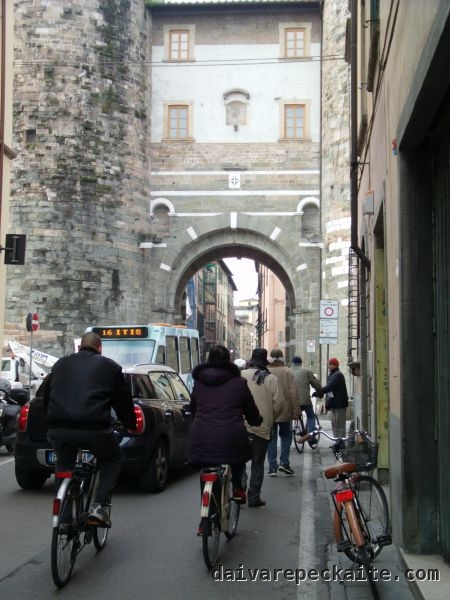
The town doesn’t end within its walls (which have remained fully intact) – there are some parts beyond them, but the walls give the old town of Lucca a neat and clear shape. There are several triangle-shaped areas, supposedly built for defense purposes, which are now filled with parks and restaurants. This is one of them from the outside.
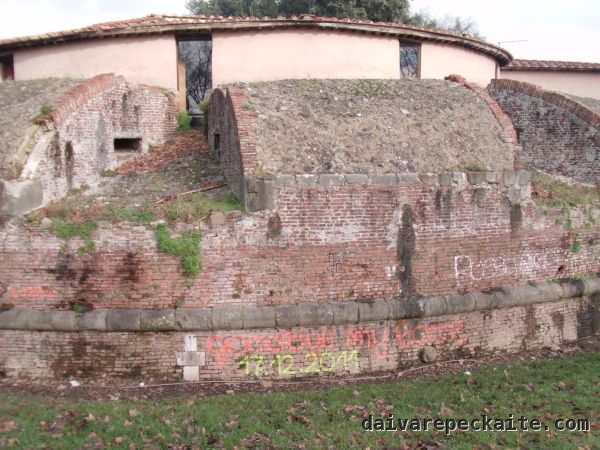
Inside, one will definitely take some compulsory shots of old winding streets.
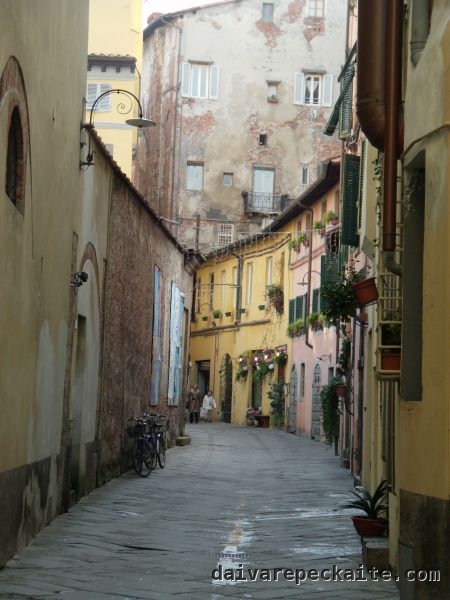
Piazza Napoleone is one interesting place – I saw people skating there in a skating rink. Lucca seems to be one more place in addition to Vilnius where Napoleon is very popular.
There are many old churches in Lucca, but most of them were not exactly to my taste. My favorite ones were on Piazza S. Pierino and Piazza S. Frediano. There were religious symbols elsewhere around the town.
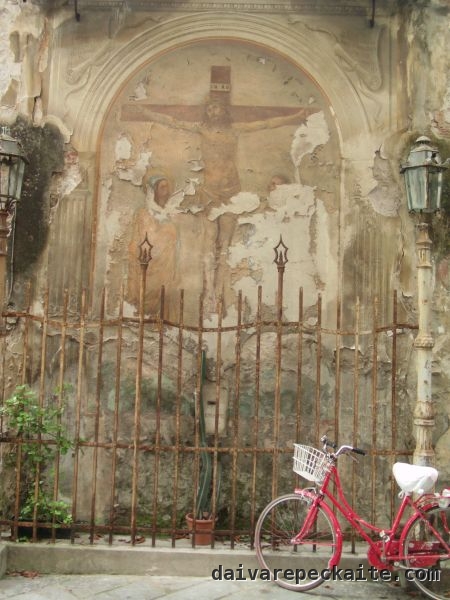
Piazza S. Salvatore looked quite impressive and cozy.
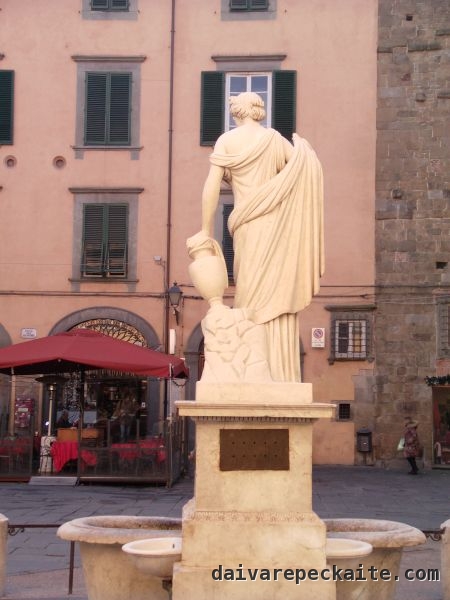
The Piazza Anfiteatro is an interesting structure. It looks impressive on the map, but in fact, what remained is a round square surrounded with houses. Only the shape is sustained.
Lucca is famous for numerous musical festivals, which fill its beautiful spaces.
After touring the town on the ground, I went to the Guinigi Tower, which is famous for having trees planted on top. The inside of the tower is decorated with medieval paintings…
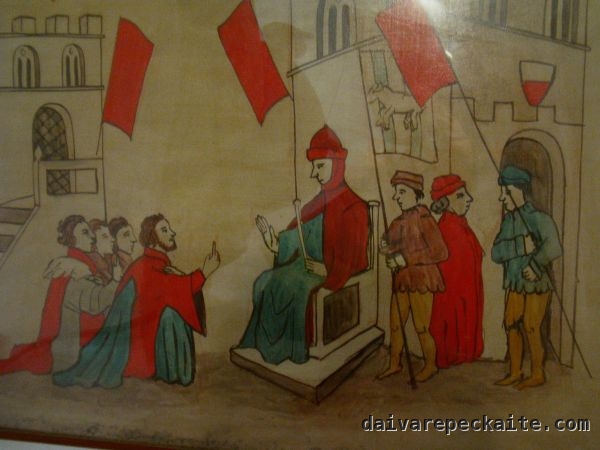
… and from the top of the tower, there is a nice view of the town.
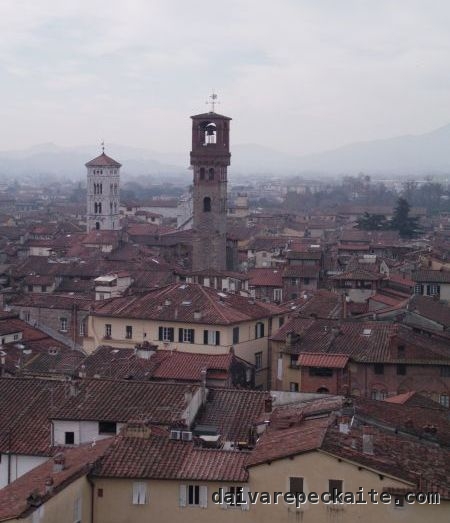
After a whole day of exploring, I went to a bar with my friend – we were about to enjoy one of the traditional Italian happy hours. I first got acquainted with the concept in an Italian bar in Luxembourg, and I also enjoyed it in Milan. Everyone who buys a drink gets free snacks. That place in Lucca offered prosciutto, cheeses and some other snacks. I tried some cheese, and then I was about to try the local ham, which looks like this:
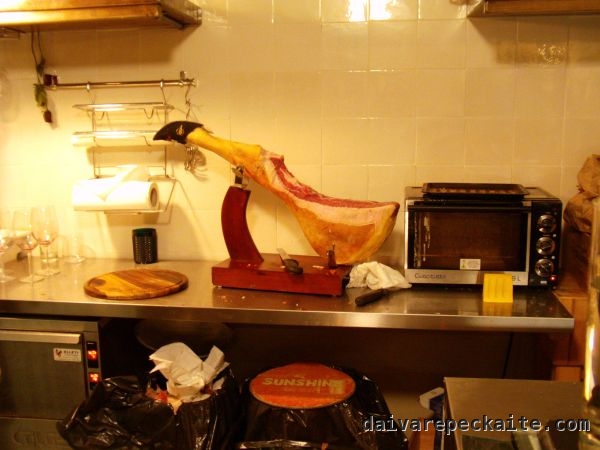
I picked up a small piece of bread and put the ham on top of it. “Don’t be surprised if people stare at you – you’ve just revealed yourself not to be local,” my friend warned. What happened? Oh, apparently you’re not supposed to put prosciutto on bread. Oh no! Now the locals won’t consider me classy! How tragic! I couldn’t care more! Umm NOT 🙂
At least Italian food, including bar snacks, is as good as they say.
Our journey continued in Viareggio, a small town close to the sea.
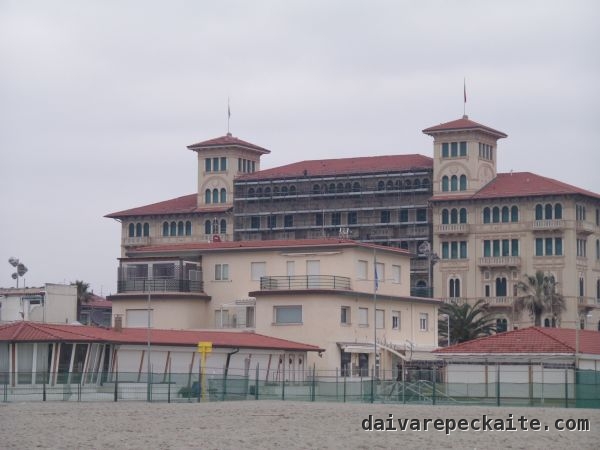
Its location and simple beauty attracts locals and foreign tourists alike. There seem to be many Russian tourists.
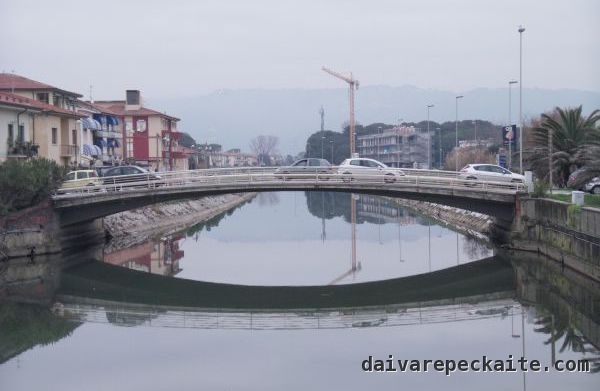
There is a popular cafe that is built on a bridge straight into the sea. Extremely expensive, but the view is worth it.
Of course, we had to include a compulsory visit to Pisa in our journey.

Among other things, Pisa seems to be Italy’s capital of leather handbags.
But that’s not all that I saw in Italy – I’ll blog more next time.

